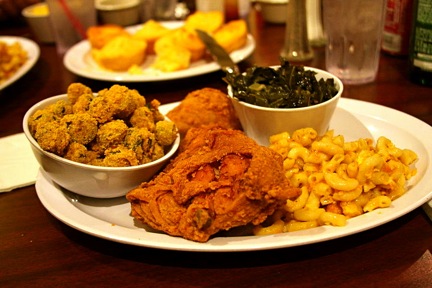In today’s world you’d be hard pressed to find a style of food that is not available to you, especially in Los Angeles. But even with the multitude of food choices available, there is still something special and comforting about indulging in a flavorful soul food meal.
Soul food is a cornerstone of African American culture, but do you know how that came to be?
The term “soul food” was not recognized until the 1960’s. According to Webster’s dictionary, the first known use of the term was in 1964. However, the food that we presently label as soul food developed since times of slavery.
Frederick Douglass Opie, author of Hog and Hominy: Soul Food from Africa to America, explains in his book that slaves in the U.S. were forced to engage in arduous tasks, and as a result burned more than 3000 calories per day. While it was important for the slaves to eat well to have enough strength for their work, slave owners only provided throwaways to feed laborers. African American women would use West African cooking techniques that included stewing and frying in order to create dishes that were higher in fat, sodium, cholesterol, and calories. This turned the throwaway food into meals with enough nutrients to sustain the slaves during their days of labor.
Opie goes on to write that after slavery was abolished, the Jim Crow segregation laws still made it difficult for African Americans to eat out at restaurants. As an alternative, they would come together for home cooked meals, which became an important part of community and belonging. Individuals who moved north during The Great Migration brought recipes with them, using them in clubs and restaurants. These traditions became part of the African American cultural identity by the 1960s.
Soul food is often construed as unhealthy in essence. Over the years, the preparation of soul food has included more meats and higher fat and salt content. However, this was not initially the characteristic of soul food. In an article for Oprah Magazine, writer Celia Barbour discusses how after reading Frederick Douglass Opie’s book, she became aware that “The traditional West African diet was predominantly vegetarian, centered on things like millet rice, field peas, okra, hot peppers, and yams. Meat was used sparingly, as a seasoning.” Barbour went on to describe her interactions with different soul food cooks who explained that African Americans only need small portions of meat and huge amounts of vegetables because food has the power to transform the body. It is possible to avoid some of the prevalent diseases among African Americans if individuals are mindful of their diet.
More recently, cooks have successfully made attempts at creating the same iconic food through healthier means. According to Encyclopedia Britannica, “Contemporary cooks have sought to limit the use of animal fat and salt, especially in light of the prevalence of high blood pressure and diabetes in the African American population.”
Byron Hurt, filmmaker of the documentary Soul Food Junkies, expresses an inspired sentiment on the subject: “Finding ways to make soul food healthy and eating it in moderation allows us to continue to enjoy the food we love and like a healthy life.”

